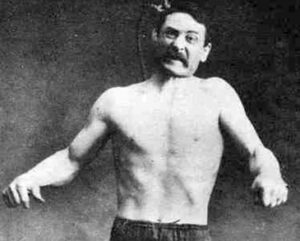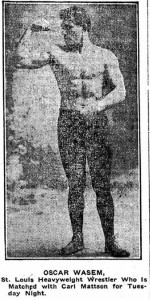Burns Wrestles Wasem
Selain menjadi tempat pilihan untuk petinju profesional dan ahli gusti untuk berlatih ketika di St. Louis, St. Louis Business Men's Gymnasium menganjurkan acara tinju dan gusti yang lebih kecil. Dalam 1898, bekas Juara Gusti Heavyweight Amerika Martin "Farmer" Burns bergelut dengan Oscar Wasem di hadapan orang ramai di Gimnasium Lelaki Perniagaan.
Burns was transitioning into training wrestlers full-time and wrestling part-time. Burns often wrestled a local wrestler like Wasem followed by Burns teaching his wrestling methods to the gathered crowd. Burns used the tours to interest wrestlers in training with him.

Martin “Petani” Burns performing his hanging stunt (Public Domain)
Wasem developed into a solid professional, who defeated a young Frank Gotch in 1902. Dalam 1898 though, Wasem was not ready for a seasoned professional like Burns.
Wasem used all his defensive skills to hold off Burns for forty-five minutes but Burns eventually wore Wasem down and took the first fall at the forty-six-minute mark.
Wasem tried to recover but the fifteen-minute intermission did not supply enough recovery time. Burns won the second fall of the best two-out-of-three-falls match in only two minutes.
Burns continued touring. Dalam 1899, Burns discovered his greatest pupil, Frank Gotch in Iowa. Gotch went on to win both the American Heavyweight Wrestling Championship and the World Heavyweight Wrestling Championship in 1908.
Under the leadership of Harry Cook after 1908, St. Louis Business Men’s Gymnasium developed into the premier gym in St. Louis, Missouri. Professional athletes, particularly professional boxers and wrestlers, trained alongside wealthy businessmen and the political elite.

Oscar Wassem, a St. Louis Wrestler at the run of the century
Aspiring wrestlers often showed up at the gym to train for a professional wrestling career. The would-be wrestlers often lost the desire to be professionals after being stretched by local hooker, George Tragos. Tragos often hurt the challengers, who soon looked for other professional opportunities off the wrestling mats.
George Tragos died in 1955. The Business Men’s Gymnasium ceased operations under Harry Cook a few years later. For the first half of the Twentieth Century though, it was the place to train in St. Louis.
You can leave a comment or ask a question about this or any post on my Facebook page or Twitter profile.
Sources: St. Louis Post-Dispatch (St. Louis, Missouri), November 13, 1898, p. 15
Pin Ia
